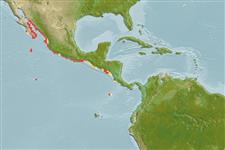>
Blenniiformes (Blennies) >
Chaenopsidae (Pike-, tube- and flagblennies)
Etymology: Acanthemblemaria: Greek, akantha = thorn + Greek, emblema, -atos, anything that is nailed, knocked in; also anything with bass or high relief (Ref. 45335).
Environment: milieu / climate zone / rango de profundidad / distribution range
Ecología
marino asociado a arrecife; rango de profundidad 2 - 15 m (Ref. 11482). Tropical; 29°N - 4°N, 112°W - 85°W (Ref. 56271)
Eastern Central Pacific: southern Baja California to Acapulco in Mexico and the Revillagigedo Islands.
Tamaño / Peso / Age
Madurez: Lm ? range ? - ? cm
Max length : 6.0 cm TL macho / no sexado; (Ref. 11482)
Short description
Claves de identificación | Morfología | Morfometría
This species is distinguished from A. hastingsi in having melanophores on the lower jaws that do not reach all the way to the distal end; it possess a red primary bright head color (vs. orange), and the windowing effect around that color is not present or is less distinct; almost not having melanophores reaching the base of the first dorsal fin and more typically have a dark, round spot or stretched out spot instead of a swath (Ref. 84469).
Body shape (shape guide): elongated.
Inhabits empty barnacles and worm or mollusk tubes on rocky reefs. Feeds on zooplankton.
Life cycle and mating behavior
Madurez | Reproducción | Puesta | Huevos | Fecundidad | Larva
Allen, G.R. and D.R. Robertson, 1994. Fishes of the tropical eastern Pacific. University of Hawaii Press, Honolulu. 332 p. (Ref. 11482)
IUCN Red List Status (Ref. 130435: Version 2025-1)
Threat to humans
Harmless
Human uses
Herramientas
Special reports
Download XML
Fuentes de Internet
Estimates based on models
Preferred temperature (Referencia
123201): 23.3 - 29.1, mean 28 °C (based on 129 cells).
Phylogenetic diversity index (Referencia
82804): PD
50 = 0.5000 [Uniqueness, from 0.5 = low to 2.0 = high].
Bayesian length-weight: a=0.00525 (0.00219 - 0.01260), b=3.06 (2.85 - 3.27), in cm total length, based on LWR estimates for this (Sub)family-body shape (Ref.
93245).
Nivel trófico (Referencia
69278): 3.4 ±0.45 se; based on food items.
Fishing Vulnerability (Ref.
59153): Low vulnerability (10 of 100).
🛈
Nutrients (Ref.
124155): Calcium = 175 [87, 335] mg/100g; Iron = 0.905 [0.511, 1.595] mg/100g; Protein = 18 [17, 19] %; Omega3 = 0.101 [0.051, 0.195] g/100g; Selenium = 18.1 [7.9, 42.8] μg/100g; VitaminA = 345 [107, 1,147] μg/100g; Zinc = 2.19 [1.39, 3.27] mg/100g (wet weight);
